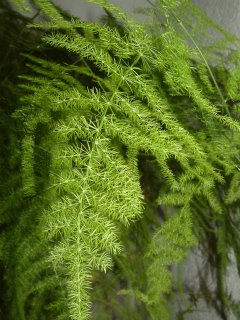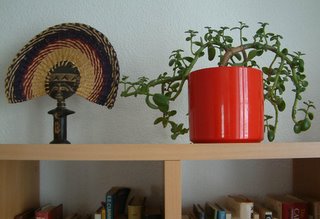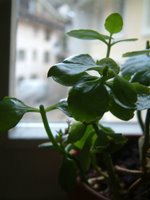The indoor garden
 November has finally sat upon us, as she does every year, leaving us breathless and struggling to come out from under. Snow is predicted and the weather is gloomy.
November has finally sat upon us, as she does every year, leaving us breathless and struggling to come out from under. Snow is predicted and the weather is gloomy.
For days like this we grow houseplants. They offer us a reassuring touch of green.
Well, they should be green, most of them. But when they finally receive my full attention, at the start of winter, I usually discover that they all look a little less green and a little less full than when I bought them at the garden center or store. Scraggly is probably the word to use with most of them. Brown tips on leaves are the scars left by plantsitters who over- or underwatered during the summer. Pale, wobbly stems on bedroom plants are a reminder that my son sometimes forgets to open his shutters for a few days (his nightlife is livelier than his daylife).
Outdoor plants are divas, with the capacity to look glorious, but if you look away for a moment, then glance back, they can be in their death throes, often quite dramatically. You can almost always woo them back just as quickly. Such relationships are driven by passion. We need the respite of winter from this opera of the growing world.
Houseplants, with us year in and year out, are a more stable, and frankly, more boring group. They have the obstinacy of plain children in a family of beauties. If they decide life is not worthwhile, they stay on the road to death no matter what you do or say to them. Mostly, they grow steadily and quietly and, in my hands, not very illustriously.

This contrary plant insists that all new growth must be on one side, no matter where the sun is. I try to convince it that there is beauty in balance.
Clearly, they need our love and, in fairness, they deserve it. Good reasons to own houseplants: they improve the air around us, they brighten rooms, their watering schedules help us -
I've just struggled to find something positive to say about the need to water them, but I can't think of anything. One of my sisters used to take the easy route, with a large house filled with plants, and wait for my mother's semi-annual visit. Not surprisingly, my mother was not impressed by my sister's plants, but they blossomed when she left. The good side to this system was that my mother always felt useful during these visits.
Every November I take stock. I vow to do better.

Orchids for a young man, flower-free
This morning I lined up in front of a brighter but sun-free window the orchids that refuse to flower. I cut off two old stalks. I gave them less water, following the instructions of my son's doctor's receptionist, who has two magnificent orchids that flower almost constantly, and have for years.
 I cut back two small plants given as gifts, which nearly died, but have obstinately stayed around. They look better already, which is reassuring.
I cut back two small plants given as gifts, which nearly died, but have obstinately stayed around. They look better already, which is reassuring. Here is a plant I have owned for a few years. What is it called? I have a poor memory for houseplant names, but I enjoy this one's stripes and I once enjoyed its shape.
Here is a plant I have owned for a few years. What is it called? I have a poor memory for houseplant names, but I enjoy this one's stripes and I once enjoyed its shape.
It suffers from poor watering every summer and by November has to have its lower leaves amputated. Every year I hope something will grow on the lower half of the plant, but after five years I have decided to either get professional advice or give up hope.
Hope, where shifting shapes and fading beauty are concerned, should never be given up too easily.
Tomorrow I will ask the gardeners at Schilliger Garden Centre about post-amputation therapy.



0 Comments:
Post a Comment
<< Home